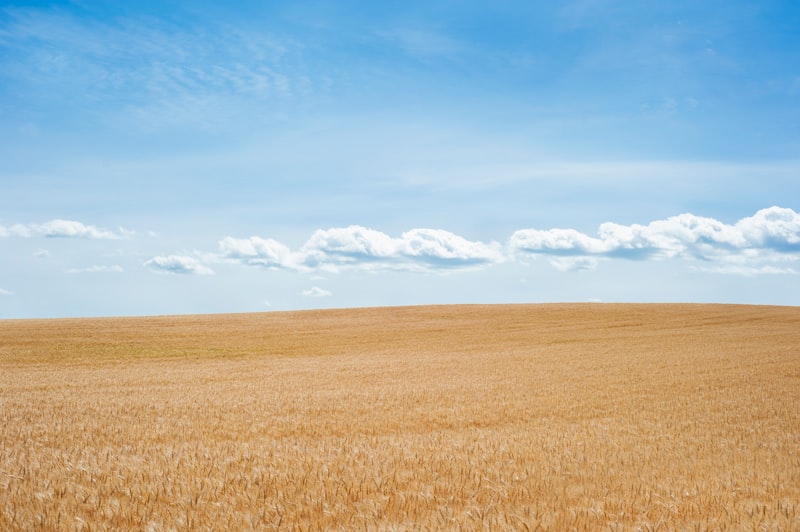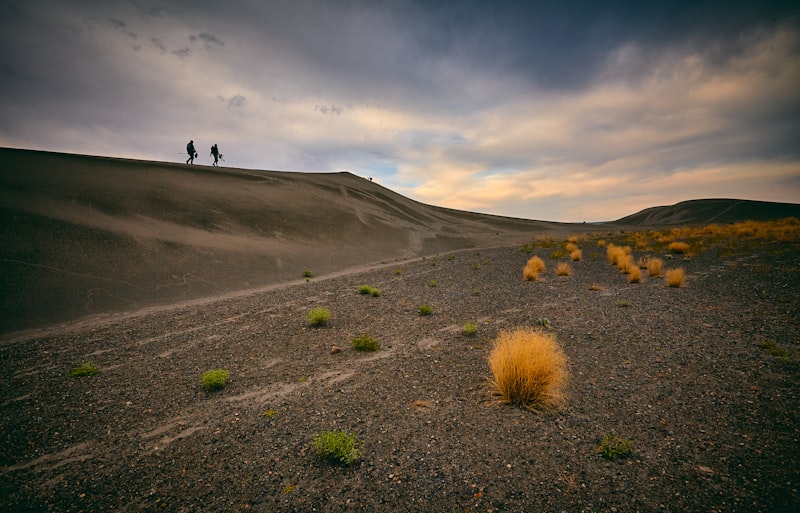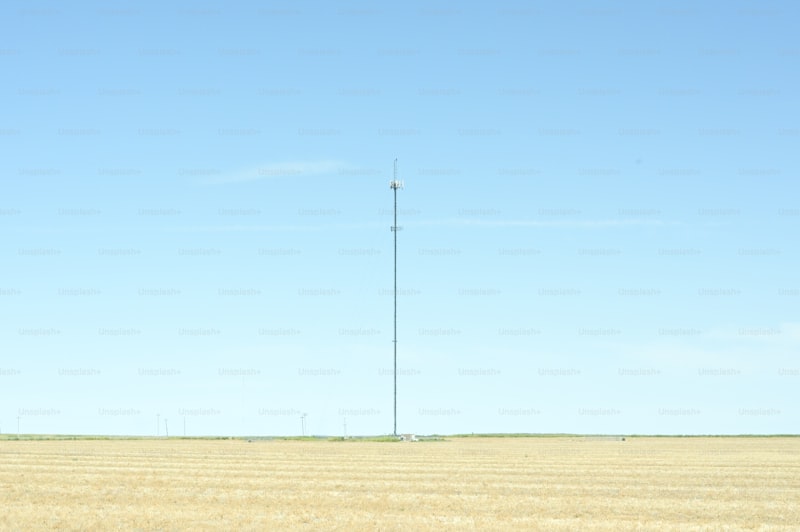In these prairies, biodiversity thrives in harmony. Diverse species of grasses create a tapestry of greens, yellows, and browns, interwoven with bursts of color from wildflowers like goldenrods, coneflowers, and blazing stars. Each season paints the landscape with its own palette – vibrant spring blooms, lush summer greenery, golden autumn hues, and the serene quiet of winter.
Wildlife finds sanctuary in these prairies, from majestic bison grazing peacefully to the nimble pronghorn racing across the plains. Birds of prey soar overhead, while smaller creatures like prairie dogs and rabbits dart among the grasses. The ecosystem of the prairie is finely tuned, where every plant and animal plays a crucial role in maintaining its delicate balance.
Beyond their natural beauty, prairies offer valuable ecological benefits. Their deep-rooted grasses help prevent soil erosion, making them essential in conserving fertile lands. They also act as carbon sinks, mitigating the effects of climate change by storing carbon dioxide from the atmosphere.
Prairies hold cultural significance as well, deeply rooted in the history and traditions of indigenous peoples. They are not just landscapes but living museums of a bygone era, where the spirit of the land whispers stories of resilience and adaptation.
Exploring a natural prairie is more than just a journey through scenery – it’s an immersive experience that connects us with the raw beauty of the Earth. It reminds us of the importance of preserving these pristine habitats for future generations to cherish and enjoy.
Unveiling the Serenity: Exploring the Hidden Charms of Prairie Landscapes
Imagine standing on the edge of a vast prairie, where the horizon stretches endlessly before you, painting a picture of serene beauty. Prairie landscapes, often overlooked for their simplicity, hold a charm that is both captivating and soul-stirring. These expansive grasslands, adorned with wildflowers and embraced by the open sky, offer a tranquil escape from the hustle of modern life.

Prairies, characterized by their flat or gently rolling terrain, are a testament to the harmonious coexistence of flora and fauna. Here, amidst the swaying grasses, one can encounter a myriad of wildlife—from grazing bison to darting prairie dogs, each contributing to the rich tapestry of this ecosystem. It’s a symphony of life where every element plays its part in maintaining the delicate balance of nature.
One of the most enchanting aspects of prairie landscapes is their ever-changing palette. In spring, the sea of green transforms into a kaleidoscope of colors as wildflowers bloom in profusion. Goldenrods, coneflowers, and sunflowers dance in the breeze, painting the landscape with hues of yellow, purple, and orange. It’s a sight that evokes wonder and admiration, a reminder of the beauty found in simplicity.
As the seasons shift, so do the prairie landscapes. Summer brings a blanket of tall grasses that sway gently in the wind, creating waves of movement across the plains. Autumn casts a golden glow as the grasses turn amber and the prairie prepares for winter’s embrace. Even in winter, when the earth rests under a blanket of snow, the prairie exudes a quiet strength, patiently awaiting the rebirth of spring.
Exploring prairie landscapes is not just a visual journey but a sensory experience. The air is crisp with the scent of wildflowers, and the sound of rustling grasses is a symphony in itself. It’s a place where time seems to slow down, allowing visitors to reconnect with nature and themselves.
Nature’s Tapestry: Captivating Colors and Textures of the American Prairie
Imagine standing amidst a vast expanse of the American prairie, where nature weaves its tapestry in breathtaking hues and textures. The prairie, with its rolling hills and expansive grasslands, paints a picture of serene beauty and raw wilderness. Here, the landscape stretches as far as the eye can see, adorned with a kaleidoscope of colors that change with the seasons.
During spring, the prairie comes alive with a burst of vibrant greens as new grass shoots up and wildflowers bloom in a riot of colors. The gentle sway of the grass in the breeze creates a mesmerizing dance, while the air is filled with the sweet scent of blossoms. It’s a time of renewal and growth, where every inch of the prairie seems to pulsate with life.
As summer arrives, the prairie transforms into a sea of golden hues, with the grasses rippling like waves under the warm sun. The endless blue sky serves as a backdrop to this natural canvas, dotted with fluffy clouds that cast shadows over the land. It’s a season of abundance, where wild grasses reach their peak and wildlife thrives amidst plenty.
Autumn casts a spell of enchantment over the prairie, painting it in warm shades of amber, crimson, and rust. The grasses take on a golden-brown hue, and the leaves of shrubs and trees turn fiery red and orange before gently drifting to the ground. The prairie becomes a patchwork of colors, blending together in a harmonious farewell to the warmth of summer.
Finally, winter arrives with its quiet beauty, blanketing the prairie in a pristine layer of snow. The landscape takes on a serene stillness, with frost-covered grasses and bare trees creating a stark yet stunning contrast against the white expanse. It’s a time of dormancy and reflection, where the prairie rests beneath the cold embrace of winter until the cycle begins anew.
In essence, the American prairie is nature’s tapestry, woven with threads of color and texture that change with the seasons. It’s a place where one can witness the marvels of nature’s artistry, each moment offering a glimpse into the timeless beauty of the natural world.
Preserving Paradise: How Conservation Efforts Are Safeguarding Prairie Ecosystems
Have you ever marveled at the vast expanse of a prairie, where endless grasslands sway with the wind, and diverse wildlife thrives in harmony? Prairie ecosystems, often overlooked in favor of more dramatic landscapes, are crucial to our planet’s biodiversity and environmental balance. Fortunately, dedicated conservation efforts are working tirelessly to preserve these precious habitats.

Prairies, with their rich soil and unique flora and fauna, play a vital role in maintaining ecological stability. They support a myriad of species, from iconic bison and prairie dogs to rare wildflowers that paint the landscape in vibrant hues. Yet, these ecosystems face significant threats from agricultural expansion, urban development, and climate change.
Conservationists and environmental organizations have taken up the mantle to protect and restore prairie ecosystems across the globe. Through strategic land management practices like controlled burns and native species reintroduction, they aim to mimic natural processes that sustain these habitats. These efforts not only conserve biodiversity but also help mitigate the effects of climate change by storing carbon in the soil and promoting water retention.
One of the key strategies employed is the establishment of protected areas and conservation easements, which safeguard large tracts of prairie from development. By creating corridors for wildlife migration and preserving critical habitats, these initiatives ensure the long-term survival of prairie species and maintain the resilience of these landscapes in the face of environmental challenges.
Education and community involvement also play pivotal roles in conservation efforts. By raising awareness about the importance of prairie ecosystems and engaging local communities in restoration projects, conservationists foster a sense of stewardship and empower individuals to contribute to preserving these natural treasures.
As we continue to witness the impacts of human activities on our planet, the conservation of prairie ecosystems stands as a beacon of hope. Through collaborative efforts and unwavering dedication, we can ensure that future generations will continue to marvel at the beauty and biodiversity of these vast grasslands.
Beyond the Horizon: Discovering the Unique Flora and Fauna of Prairie Regions

Imagine standing on the edge of a vast prairie, where the golden grass stretches endlessly under the wide, open sky. This is not just any landscape; it’s a realm teeming with a remarkable diversity of flora and fauna, each playing a vital role in this expansive ecosystem.
Prairies, often overlooked for their apparent simplicity, harbor a hidden world of biodiversity. In these grasslands, you’ll find a tapestry of wildflowers painting the landscape in vibrant hues. From the iconic purple coneflower to the delicate prairie smoke, each bloom tells a story of resilience and adaptation to the harsh prairie conditions.
But it’s not just the flora that makes prairies unique. These expansive plains are home to a variety of wildlife specially adapted to this environment. Picture the agile pronghorn antelope, effortlessly navigating through the tall grasses, or the elusive swift fox darting across the plains under the watchful eye of the soaring ferruginous hawk. These animals have evolved alongside the prairie’s rhythms, carving out niches that contribute to the delicate balance of life here.
The prairie ecosystem is a testament to the beauty of simplicity and the complexity it conceals. Beneath the surface, prairie roots form an intricate network that binds the soil, preventing erosion and storing carbon—a vital function in today’s changing climate. This resilience extends to the wildlife that call these plains home, adapting to survive fires, droughts, and the encroachment of human development.
Prairie Poetry: Inspiring Artists and Writers Through Vast Open Spaces
Imagine standing amidst a sea of golden grasses, swaying gently in the breeze like waves on an ocean. The prairie sky, a vast dome of azure, stretches overhead, painting a backdrop that shifts from the soft hues of sunrise to the fiery palette of sunset. It’s here, in this expanse, that artists find solace in the simplicity of nature’s design and writers discover stories woven into the fabric of the land.
For poets, the prairie becomes a muse—a place where words flow freely like the winds that sweep across its plains. Each blade of grass, each wildflower bending under the weight of dew, tells a story of resilience and beauty. It’s a landscape that inspires verses of longing and belonging, of solitude and companionship, echoing the human experience against the backdrop of untamed nature.
Writers, too, find themselves drawn to the prairie’s open embrace. They craft narratives that unfold like the prairie itself, with characters as complex as the changing seasons. The vastness becomes a metaphor, where plots stretch out like the horizon, offering infinite possibilities and adventures waiting to be penned.
Just as the prairie is ever-changing, so too is its impact on those who wander through its realms. It’s a place where creativity blossoms, where the mind finds clarity in the expanse, and where the spirit feels at home amidst the whispering winds. Prairie poetry isn’t just about words on a page—it’s about capturing the essence of a landscape that both humbles and inspires, leaving an indelible mark on those who dare to explore its depths.
Seasons of Splendor: The Ever-Changing Beauty of Prairie Landscapes
In spring, the prairies awaken with a burst of life. Wildflowers dot the expanse, painting it in a kaleidoscope of colors—violets, yellows, and blues swaying in the gentle breeze. The air is filled with the melody of birds returning from their winter retreats, adding a symphonic charm to the already picturesque setting. It’s a season of renewal and growth, where every inch of the prairie seems to pulsate with vitality.
As summer arrives, the prairies transform into a sea of lush greenery. Tall grasses dance gracefully under the warm sun, creating waves of emerald that stretch to the horizon. The air hums with the buzz of insects and the occasional rustle of small creatures hidden within the grass. The prairie becomes a haven for life, a thriving ecosystem where flora and fauna interplay in perfect harmony.
Autumn brings a dramatic change to the prairie landscape. The once-verdant grasses turn golden and crimson, painting the fields with a warm, earthy palette. The sky above seems bluer, contrasting beautifully with the fiery hues below. It’s a season of transition, where the prairie prepares for the quiet slumber of winter, yet still exudes a vibrant charm that captivates all who behold it.
Finally, winter descends upon the prairies with a serene grace. A blanket of snow transforms the landscape into a pristine white canvas, softening its contours and muffling its sounds. The silence is profound, broken only by the occasional creak of frost-laden branches or the distant call of a winter bird. Despite the cold, there’s a stark beauty in the simplicity of the winter prairie—a beauty that speaks of resilience and quiet introspection.
Throughout the year, the prairie landscapes undergo a continuous cycle of change, each season bringing its own unique spectacle. Whether vibrant and bustling or tranquil and serene, the beauty of the prairies never ceases to inspire awe and wonder, reminding us of nature’s boundless artistry and the timeless rhythm of the seasons.
In Harmony with Nature: The Role of Prairies in Biodiversity Conservation
One of the key aspects of prairies is their incredible biodiversity. They are home to a myriad of plant species, from the iconic tallgrass species like Big Bluestem and Indian grass to a rich tapestry of wildflowers such as Purple Coneflower and Black-eyed Susan. This diversity in plant life forms the foundation of the prairie ecosystem, providing food and habitat for countless animal species.
Speaking of animals, prairies are bustling with life. They host a variety of insects, birds, and mammals, each playing a unique role in the ecosystem. Take the prairie dog, for instance—a keystone species whose burrows provide homes for numerous other animals and help aerate the soil. Birds like the meadowlark and bobolink rely on the open grasslands for nesting and feeding, their calls blending harmoniously with the rustling of the grasses.
Beyond their ecological significance, prairies also contribute to environmental health in various ways. They act as natural carbon sinks, storing carbon dioxide in their extensive root systems and helping mitigate climate change. Additionally, prairie soils are incredibly fertile, making them valuable for agriculture while also preventing erosion and maintaining water quality.
Preserving prairies is crucial for maintaining biodiversity on a global scale. As urbanization and agriculture continue to expand, these native grasslands face threats from habitat loss and fragmentation. Conservation efforts aim to protect and restore prairie ecosystems, ensuring that future generations can continue to benefit from their ecological, aesthetic, and cultural values.
Frequently Asked Questions
What makes prairie landscapes unique and beautiful?
Discover what makes prairie landscapes unique and beautiful, from their vast expanses of native grasses and wildflowers to the diverse wildlife that thrives in this open environment. Prairies offer breathtaking vistas under expansive skies, showcasing a harmony of natural elements that define their serene beauty.
How can I visit and experience natural prairie habitats?
Discovering natural prairie habitats involves visiting designated conservation areas or national parks where these ecosystems are preserved. Look for guided tours or trails that allow you to observe native flora and fauna. Respect local regulations to protect these sensitive environments.
What are the key features of natural prairie landscapes?
Discover the key features of natural prairie landscapes, including expansive grasslands, diverse flora like wildflowers and native grasses, rich biodiversity with species adapted to prairie environments, and crucial ecological functions such as carbon storage and soil conservation.
Why are prairie landscapes important for conservation?
Learn why prairie landscapes are crucial for conservation efforts. Discover the vital role they play in preserving biodiversity, supporting native species, and maintaining ecological balance. Explore how prairies help mitigate climate change and provide essential habitats for endangered wildlife.
How do prairie ecosystems support diverse wildlife?
Discover how prairie ecosystems sustain diverse wildlife through their unique combination of grasslands, wildflowers, and climate conditions. Learn about the intricate balance of food sources, habitats, and ecological interactions that contribute to the richness of wildlife in prairies.


